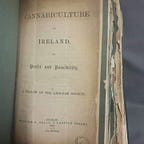Hemp and The First Transatlantic Telegraph Cable
By Brian Houlihan
(Please consider becoming a patron to support the creation of more unique content)
Two years ago simultaneous celebrations took place on Valentia Island, off the coast of Kerry, and on Hearts Content, a small island in Newfoundland, Canada. The celebrations were part of the Transatlantic Telegraphic Festival which marked the 150th anniversary of significant events linking the two countries.
The festival celebrated Kerry’s connection with the Canadian Island and both their roles in the history of transatlantic communication. 150 years previously a 3,071 kilometers long cable was laid between the two countries which revolutionised global communication.
In July 1866 the ‘SS Great Eastern’ which had set sail from Valentia Island arrived at Newfoundland in Canada. This wasn’t the first attempt either. A year previously the same mission had ended in disaster. Further attempts were made to extend the cable and/or to improve it over the following years.
Prior to this Ireland (which was still part of the British Empire) had communication cables connecting it to the Wales, Scotland and England. But few, if any, of these cables even reached 100km let alone 3000km. Before the cable it took two weeks for a message to be transferred across the Atlantic. This new technology made it more instantaneous, though still quite difficult.
This unique cable was manufactured by two companies in Liverpool. The cable required extra protection and so it was covered with a natural latex made from the gutta-percha tree. The wire was wound with tarred hemp and surrounded by a sheath of iron wire. This product was then wound in impregnated hemp.
As one commentator has stated “It was a monumental job, requiring 333,500 miles of wire and 300,000 miles of tarred hemp, to produce 3,000 miles of cable”.
It’s worth highlighting that while the SS Great Eastern was a steam powered ship it still would have utilised hemp on board as many ships did at the time.
The emergence of wireless communication (radio) in the 1920’s and the introduction of satellite communication systems in the 1960’s made such cables obsolete. However, in the age of instant communication perhaps it’s worth remembering Ireland and hemp’s small role in transforming global communications 150 years ago.
It’s worth noting that this cable was laid in 1866 which is the same year George Sigerson published his work ‘Cannabiculture in Ireland; its profit and possibility’
Brian Houlihan is the curator of the Dublin Hemp Museum and regularly writes about hemp. Follow him on Twitter @dubhempmuseum and@houlihanbrian. You can also find the museum on Facebook.
